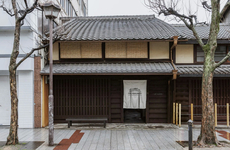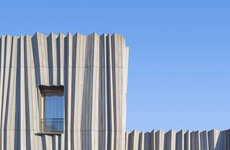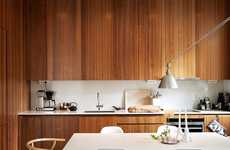
The Kayanoya Shop Offers a Community Perspective
Vasiliki Marapas — July 3, 2014 — Art & Design
References: kkaa.co.jp & contemporist
Kengo Kuma & Associates designed the Kayanoya Shop in Tokyo, Japan. Kayanoya has been manufacturing soy sauce for more than 120 years, an impressive feat to say the least. This store is a replica of its traditional warehouse, located in Kuhara Shoyu, Kyushu.
The architects chose wooden barrels, which float near the top of the building, because they are traditionally used for making Shoyu. Koji Buta acts as furniture, offering a look that is both functional and elegant. For those who are unfamiliar, koji is a malt rise which is used as a medium to make shoyu, miso and sake. The architects wished to transfer the cultural significance of these items to Nihonbashi, Tokyo.
All of the cedar materials hail from Kyushu; specifically the barrels and trays were manufactured by crasftspeople in the town. The finished result is a design that strongly identifies with a sense of community.
The architects chose wooden barrels, which float near the top of the building, because they are traditionally used for making Shoyu. Koji Buta acts as furniture, offering a look that is both functional and elegant. For those who are unfamiliar, koji is a malt rise which is used as a medium to make shoyu, miso and sake. The architects wished to transfer the cultural significance of these items to Nihonbashi, Tokyo.
All of the cedar materials hail from Kyushu; specifically the barrels and trays were manufactured by crasftspeople in the town. The finished result is a design that strongly identifies with a sense of community.
Trend Themes
1. Traditional Design Revival - Architects are bringing traditional design elements into their modern buildings as a way to honor cultural significance and promote community values.
2. Local Sourcing - Businesses are emphasizing the use of locally-sourced materials and the involvement of local craftsmen in the production process to promote community engagement and support local economies.
3. Functional Aesthetics - Designers are incorporating functional objects as furniture pieces into their spaces to add an air of elegance and intimacy while also serving a practical purpose.
Industry Implications
1. Architecture - Architects and designers have the opportunity to incorporate traditional design elements and functional objects into modern buildings to create a sense of community and cultural significance in their projects.
2. Craftsmanship - Craftsmen and local artisanal industries have the opportunity to showcase their skills and promote their work by collaborating with businesses who prioritize the use of locally-sourced materials and community engagement.
3. Retail - Businesses in the retail industry can promote community values and cultural significance by sourcing locally-made products and incorporating functional objects into their stores to promote intimacy and elegance.
1.8
Score
Popularity
Activity
Freshness























